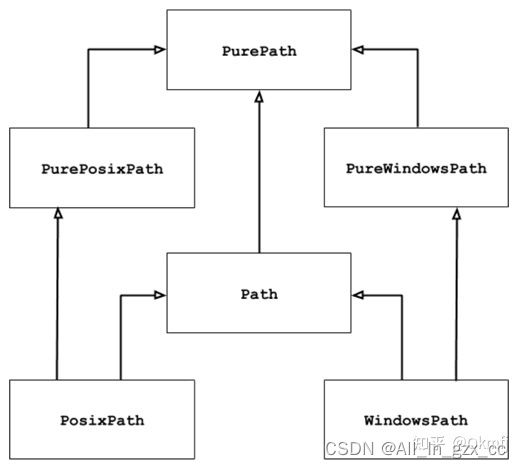【python第三方库】路径操作模块pathlib详解
本文转载自 知乎,仅作学习记录
文章目录
- 一、pathlib简介
-
- 1. PurePath
- 2. Path
- 3. PurePath和Path的区别
- 4. UNIX和Windos风格路径的区别
- 二、pathlib和os的区别
-
- 1. pathlib优势
- 2. pathlib和os常用操作对比
- 三、具体使用方法
-
- 1. 路径获取
-
- 传入字符串
- 目录拼接
- 2. 路径处理
- 3. 路径判断
- 4. 路径建立、删除
- 5. 路径匹配查找(迭代)
-
- iterdir方法
- glob方法
- rglob方法
- 6. 读、写文件
- 7. 属性和方法汇总
-
- PurePath 类属性和方法汇总
- Path 类属性和方法汇总
- 四、应用示例
-
- 1. 示例1:获取文件列表(函数)
- 2. 示例2:定义文件路径
- 五、 总结
一、pathlib简介
pathlib是跨平台的、面向对象的路径操作模块,可适用于不同的操作系统,其操作对象是各种操作系统中使用的路径(包括绝对路径和相对路径),pathlib有两个主要的类,分别为PurePath和Path。

1. PurePath
PurePath访问实际文件系统的“纯路径”,只负责对路径字符串执行操作。PurePath有两个子类,即PurePosixPath和PathWindowsPath,前者用于操作UNIX(包括 Mac OS X)风格的路径,后者用于操作Windows风格的路径。
2. Path
Path访问实际文件系统的“真正路径”,Path对象可用于判断对应的文件是否存在、是否为文件、是否为目录等。有两个子类,即PosixPath和WindowsPath,前者用于操作UNIX(包括 Mac OS X)风格的路径,后者用于操作Windows风格的路径。
3. PurePath和Path的区别
Path 是 PurePath 的子类,除了支持 PurePath 的各种操作、属性和方法之外,还会真正访问底层的文件系统,包括判断 Path 对应的路径是否存在,获取 Path 对应路径的各种属性(如是否只读、是文件还是文件夹等),甚至可以对文件进行读写。
PurePath 和 Path 最根本的区别在于,PurePath 处理的仅是字符串,而 Path 则会真正访问底层的文件路径,因此它提供了属性和方法来访问底层的文件系统。
4. UNIX和Windos风格路径的区别
UNIX 风格的路径和 Windows 风格路径的主要区别在于根路径和路径分隔符,UNIX 风格路径的根路径是斜杠(/),而 Windows 风格路径的根路径是盘符(c:);UNIX 风格的路径的分隔符是斜杠(/),而 Windows 风格路径的分隔符是反斜杠(\)。
注意:
考虑到操作系统的不同,在使用 PurePath 类时,如果在 UNIX 或 Mac OS X 系统上使用 PurePath 创建对象,该类的构造方法实际返回的是 PurePosixPath 对象;反之,如果在 Windows 系统上使用 PurePath 创建对象,该类的构造方法返回的是 PureWindowsPath 对象。
考虑到操作系统的不同,Path 类的使用同 PurePath 类。
二、pathlib和os的区别
- 在Python 3.4之前,涉及路径相关操作,都用os模块解决,尤其是
os.path这个子模块非常有用。 - 在Python 3.4之后,pathlib成为标准库模块,其使用面向对象的编程方式来表示文件系统路径,丰富了路径处理的方法。
1. pathlib优势
相对于传统的os及os.path,pathlib具体如下优势:
- pathlib实现统一管理,解决了传统操作导入模块不统一问题;
- pathlib使得在不同操作系统之间切换非常简单;
- pathlib是面向对象的,路径处理更灵活方便,解决了传统路径和字符串并不等价的问题;
- pathlib简化了很多操作,简单易用。
2. pathlib和os常用操作对比
通过常用路径操作的对比,可以更深刻理解pathlib和os的区别,便于在实际操作中做对照,也便于进行使用替代,详细对比如下:

三、具体使用方法
以下操作是在Windows系统内完成的。
1. 路径获取
传入字符串
在创建PurePath和Path时,既可以传入单个字符串,也可传入多个路径字符串,PurePath会将它们拼接成一个字符串。
from pathlib import *
PurePath('M工具箱','MTool工具/示例','info')
# 结果: PureWindowsPath('M工具箱/MTool工具/示例/info')
Path('M工具箱')
# 结果: WindowsPath('M工具箱')
input_path = r"C:\Users\okmfj\Desktop\MTool工具"
Path(input_path)
# 结果: WindowsPath('C:/Users/okmfj/Desktop/MTool工具')
- 获取目录
- Path.cwd(),返回文件当前所在目录;
- Path.home(),返回电脑用户的目录。
from pathlib import *
Path.cwd()
# 结果: WindowsPath('D:/M工具箱')
Path.home()
# 结果: WindowsPath('C:/Users/okmfj')
目录拼接
拼接出Windows桌面路径,当前路径下的子目录或文件路径。
from pathlib import *
# 拼接出Windows桌面路径
Path(Path.home(), "Desktop")
# 结果: WindowsPath('C:/Users/okmfj/Desktop')
# 拼接出Windows桌面路径
Path.joinpath(Path.home(), "Desktop")
# 结果: WindowsPath('C:/Users/okmfj/Desktop')
# 拼接出当前路径下的“MTool工具”子文件夹路径
Path.cwd() / 'MTool工具'
# 结果: WindowsPath('D:/M工具箱/MTool工具')
2. 路径处理
获取路径的不同部分、或不同字段等内容,用于后续的路径处理,如拼接路径、修改文件名、更改文件后缀等。
from pathlib import *
input_path = r"C:\Users\okmfj\Desktop\MTool工具"
Path(input_path).name # 返回文件名+文件后缀
Path(input_path).stem # 返回文件名
Path(input_path).suffix # 返回文件后缀
Path(input_path).suffixes # 返回文件后缀列表
Path(input_path).root # 返回根目录
Path(input_path).parts # 返回文件
Path(input_path).anchor # 返回根目录
Path(input_path).parent # 返回父级目录
Path(input_path).parents # 返回所有上级目录的列表
3. 路径判断
Path.exists(),判断 Path 路径是否是一个已存在的文件或文件夹;Path.is_dir(),判断 Path 是否是一个文件夹;Path.is_file(),判断 Path 是否是一个文件。
from pathlib import *
input_path = r"C:\Users\okmfj\Desktop\MTool工具"
if Path(input_path ).exists():
if Path(input_path ).is_file():
print("是文件!")
elif Path(input_path ).is_dar():
print("是文件夹!")
else:
print("路径有误,请检查!")
4. 路径建立、删除
Path.mkdir(),创建文件夹;Path.rmdir(),删除文件夹,文件夹必须为空;Path.unlink(),删除文件。
from pathlib import *
input_path = r"C:\Users\okmfj\Desktop\MTool工具"
# 创建文件夹函数
def creat_dir(dir_path):
if Path(dir_path).exists(): # 如果已经存在,则跳过并提示
print("文件夹已经存在!")
else:
Path.mkdir(Path(dir_path)) # 创建文件夹
creat_dir(input_path ) # 调用函数
# 删除文件夹函数
def del_dir(dir_path):
if Path(dir_path).exists(): # 如果存在,则删除文件夹
Path.rmdir(Path(dir_path))
else:
print("文件夹不存在!") # 文件夹不存在
del_dir(input_path ) # 调用函数
# 删除文件函数
def del_file(dir_path):
if Path(dir_path).exists(): # 如果存在,则删除文件
Path.unlink()(Path(dir_path))
else:
print("文件不存在!") # 文件不存在
del_file(input_path ) # 调用函数
5. 路径匹配查找(迭代)
Path.iterdir(),查找文件夹下的所有文件,返回的是一个生成器类型;Path.glob(pattern),查找文件夹下所有与 pattern 匹配的文件,返回的是一个生成器类型;Path.rglob(pattern),查找文件夹下所有子文件夹中与 pattern 匹配的文件,返回的是一个生成器类型。
iterdir方法
from pathlib import *
input_path = r"C:\Users\okmfj\Desktop\MTool工具"
# 获取文件夹下所有文件,返回文件路径(字符)列表,采用iterdir方法
[str(f) for f in Path(x).iterdir() if Path(f).is_file()]
# 获取文件夹下所有文件类型,返回文件后缀的列表,采用iterdir方法
list(set([Path(f).suffix for f in Path(x).iterdir() if Path(f).is_file()]))
# 结果: ['.pdf', '.txt', '.docx']
glob方法
from pathlib import *
input_path = r"C:\Users\okmfj\Desktop\MTool工具"
# 获取文件夹下所有文件,返回文件路径(字符)列表,采用glog方法
[str(f) for f in Path(input_path).glob(f"*.*") if Path(f).is_file()]
# 获取文件夹下所有文件,返回文件路径(字符)列表,采用glog方法
[str(f) for f in Path(input_path).glob(f"**\*.*") if Path(f).is_file()]
# 获取文件夹下所有文件类型,返回文件后缀的列表,采用glog方法
list(set([Path(f).suffix for f in Path(input_path).glob(f"*.*") if Path(f).is_file()]))
# 结果: ['.pdf', '.txt', '.docx']
# 获取文件夹下(含子文件)所有文件类型,返回文件后缀的列表,采用glog方法
list(set([Path(f).suffix for f in Path(x).glob(f"**\*.*") if Path(f).is_file()]))
# 结果: ['.pdf', '.txt', '.docx']
rglob方法
from pathlib import *
input_path = r"C:\Users\okmfj\Desktop\MTool工具"
# 获取文件夹下(含子文件)所有文件,返回文件路径(字符)列表,采用rglog方法
[str(f) for f in Path(x).rglob(f"*.*") if Path(f).is_file()]
# 获取文件夹下(含子文件)所有文件类型,返回文件后缀的列表,采用rglog方法
list(set([Path(f).suffix for f in Path(x).rglob(f"*.*") if Path(f).is_file()]))
# 结果: ['.pdf', '.txt', '.docx']
6. 读、写文件
Path.open(mode='r'),以 “r” 格式打开 Path 路径下的文件,若文件不存在即创建后打开。Path.read_bytes(),打开 Path 路径下的文件,以字节流格式读取文件内容,等同 open 操作文件的 “rb” 格式。Path.read_text(),打开 Path 路径下的文件,以 str 格式读取文件内容,等同 open 操作文件的 “r” 格式。Path.write_bytes(),对 Path 路径下的文件进行写操作,等同 open 操作文件的 “wb” 格式。Path.write_text(),对 Path 路径下的文件进行写操作,等同 open 操作文件的 “w” 格式。
from pathlib import *
input_path = r"C:\Users\okmfj\Desktop\MTool工具\1.txt"
with Path(input_path).open('w') as f: # 创建并打开文件
f.write('M工具箱') # 写入内容
f = open(input_path, 'r') # 读取内容
print(f"读取的文件内容为:{f.read()}")
f.close()
7. 属性和方法汇总
PurePath 类属性和方法汇总
Path 类属性和方法汇总
四、应用示例
1. 示例1:获取文件列表(函数)
通过函数,返回文件列表,为后续迭代处理做好准备。
参数:
- path:输入路径,支持文件路径和文件夹路径。
- sub_dir:当为True时含子目录,为False时不含子目录
- suffix_list:文件类型列表,按要求的列出全部符合条件的文件,为空时列出全部文件,如:[“.xlsx”,“.xls”]
from pathlib import *
def file_list_handle(path, sub_dir=False, suffix_list=[]):
"""
path:输入路径,支持文件路径和文件夹路径
sub_dir:当为True时含子目录,为False时不含子目录
suffix_list:文件类型列表,按要求的列出全部符合条件的文件,为空时列出全部文件,如:[".xlsx",".xls"]
"""
file_list = []
if not suffix_list:
if sub_dir:
[suffix_list.append(Path(f).suffix) for f in Path(path).glob(f"**\*.*") if Path(f).is_file()]
else:
[suffix_list.append(Path(f).suffix) for f in Path(path).glob(f"*.*") if Path(f).is_file()]
suffix_list = list(set(suffix_list))
# [print(i) for i in suffix_list]
if Path(path).exists():
# 目标为文件夹
if Path(path).is_dir():
if sub_dir:
for i in suffix_list:
[file_list.append(str(f)) for f in Path(path).glob(f"**\*{i}")]
else:
[file_list.append(str(f)) for f in Path(path).iterdir() if Path(f).is_file and f.suffix in suffix_list]
elif Path(path).is_file():
file_list = [path]
# 去除临时文件
file_list_temp = []
for y in file_list:
if "~$" in Path(y).stem:
continue
file_list_temp.append(y)
file_list = file_list_temp
return file_list
else:
print("输入有误!")
return []
2. 示例2:定义文件路径
在输入文件路径的基础上,通过函数,构造输出文件路径,为后续处理、存储做好准备。
参数:
- in_path:输入文件路径
- path_str:文件路径构造字符
- file_suffix:输出文件后缀
from pathlib import *
from datetime import datetime
input_path = r"C:\Users\hp\Desktop\MTool工具\1.txt"
def out_path_handle(in_path, path_str="", file_suffix=""):
"""
in_path:输入文件路径
path_str:文件路径构造字符
file_suffix:输出文件后缀
"""
if path_str == "":
path_str = str(datetime.now()).replace(":", "").replace(" ", "_").replace("-", "").replace(".", "_")[
:22]
elif path_str[-1] == "_":
path_str = path_str + str(datetime.now()).replace(":", "").replace(" ", "_").replace("-", "").replace(
".", "_")[:22]
if file_suffix == "":
file_suffix = Path(in_path).suffix
if Path(in_path).exists():
if Path(in_path).is_dir():
path = Path(in_path).joinpath(path_str + file_suffix)
elif Path(in_path).is_file():
path = Path(in_path).parent.joinpath(Path(in_path).stem + "_" + path_str + file_suffix)
return path
else:
print("输入有误!")
return []
# 调用函数
out_path_handle(input_path,"已处理",".xlsx")
# 结果: WindowsPath('C:/Users/hp/Desktop/MTool工具/1_已处理.xlsx')
# 调用函数
out_path_handle(input_path,"_",".xlsx")
# 结果:WindowsPath('C:/Users/hp/Desktop/MTool工具/1_20220304_135344_003210.xlsx')
五、 总结
以上详细介绍了Python中路径操作的标准模块:pathlib,鉴于pathlib的优势,建议在python中优先使用,可以使路径处理更简洁、路径处理错误更少、编程效率更高、代码更易读。
其他未尽情况,可参见官方文档:pathlib - pathlib 1.0.1 documentation


